

Choose Your Own Statistics. Get Informed. Keen to learn more about human rights?
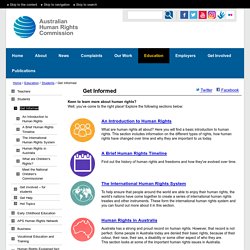
Well, you’ve come to the right place! Explore the following sections below: An Introduction to Human Rights What are human rights all about? Here you will find a basic introduction to human rights. How young people can get involved in human rights. Human rights are an important part of our lives.
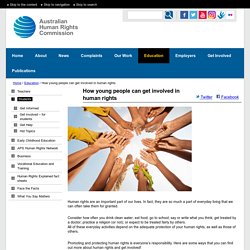
In fact, they are so much a part of everyday living that we can often take them for granted. Consider how often you drink clean water; eat food; go to school; say or write what you think; get treated by a doctor; practice a religion (or not); or expect to be treated fairly by others.All of these everyday activities depend on the adequate protection of your human rights, as well as those of others.
A Brief Human Rights Timeline. In Babylon King Hammurabi draws up the ‘Code of Hammurabi’, an early legal document that promises to ‘make justice reign in the Kingdom and promote the good of the people’ c. 528 BCE - 486 BCE In India, Gautama Buddha advocates morality, reverence for life, non-violence and right conduct Confucian teaching develops based on 'jen' or benevolence and respect for other people.

Australian Rights Timeline. Human Rights in Australia. Human rights are an important part of our lives.
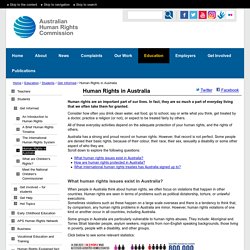
In fact, they are so much a part of everyday living that we often take them for granted. Consider how often you drink clean water, eat food, go to school, say or write what you think, get treated by a doctor, practice a religion (or not), or expect to be treated fairly by others. Agenda for racial equality 2012-2016 - Timeline. Timeline 1606 – First recorded contact between Aboriginal peoples and Dutch traders. 1788 – The First Fleet arrives, marking the start of European colonisation of Australia on the basis that the land belongs to no-one (‘terra nullius’). 1839 – The first refugees arrive in Australia – Prussian Lutherans – who settle in South Australia.[83] 1850’s – The first gold rush brings large-scale immigration from Europe and Asia.
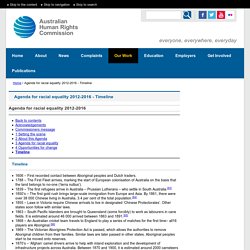
By 1861, there were over 38 000 Chinese living in Australia, 3.4 per cent of the total population.[84] 1855 – Laws in Victoria require Chinese arrivals to live in designated ‘Chinese Protectorates’. Other states soon follow with similar laws. 1863 – South Pacific Islanders are brought to Queensland (some forcibly) to work as labourers in cane fields. ^Top [83] Refugee Council of Australia, History of Australia's refugee program, (viewed 5 August 2012).[84] Department of Immigration and Multicultural Affairs, Immigration: Federation to Century’s End 1901-2000 (2001), p48. Women's Rights. Women’s rights are human rights.
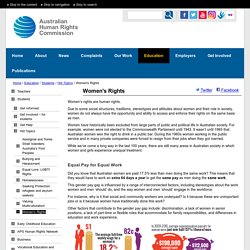
Due to some social structures, traditions, stereotypes and attitudes about women and their role in society, women do not always have the opportunity and ability to access and enforce their rights on the same basis as men. Women have historically been excluded from large parts of public and political life in Australian society. For example, women were not elected to the Commonwealth Parliament until 1943. It wasn’t until 1965 that Australian women won the right to drink in a public bar.
Aboriginal and Torres Strait Islanders: Australia’s First Peoples. Australia is home to the oldest continuing living culture in the entire world.
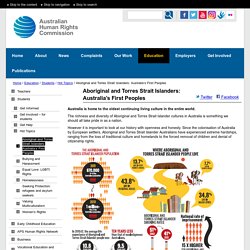
The richness and diversity of Aboriginal and Torres Strait Islander cultures in Australia is something we should all take pride in as a nation. However it is important to look at our history with openness and honesty. Since the colonisation of Australia by European settlers, Aboriginal and Torres Strait Islander Australians have experienced extreme hardships, ranging from the loss of traditional culture and homelands to the forced removal of children and denial of citizenship rights. This history of injustice has meant that many Aboriginal and Torres Strait Islanders have been denied access to basic human rights, such as rights to health, housing, employment and education.
Human Rights Explained: Index. Amnesty.org. Amnesty.org. In 1948, following the traumatic events of World War II, representatives from the 50 member states of the United Nations banded together to create a list of the rights everyone around the world should enjoy.

Asanka Brendon Ratnayake/Anadolu Agency/Getty Images. Timeline - TimelineTimeline. Timeline: Immigration Museum. Ideas about whiteness and the value of racial purity inform restrictive immigration policies in the USA, South Africa, Canada, New Zealand and Australia.
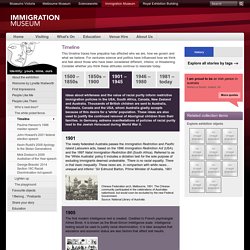
Thousands of British children are sent to Australia, Rhodesia, Canada and the USA, whom Australia gladly accepts because of this desire for a 'white' population. These ideas are also used to justify the continued removal of Aboriginal children from their families. Timeline. Timeline: Australia's Immigration Policy. 1831 – 43 years after the arrival of the First Fleet and the beginning of British colonisation in Australia, the first assisted migration begins with workers from Britain encouraged to apply.
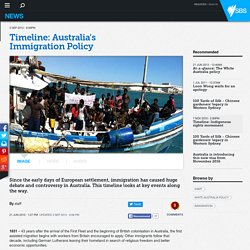
Other immigrants follow that decade, including German Lutherans leaving their homeland in search of religious freedom and better economic opportunities. 1860 – Many Chinese miners take advantage of Australia's Gold Rush, but it causes tensions that come to a head in an 1860 riot. 3,000 European miners drive the Chinese off the Burrangong Goldfield in New South Wales. Timeline: Indigenous rights movement. Here is an overview of the Indigenous rights movement from the beginning of the century. 1901: Commonwealth of Australia formed. Indigenous Australians are excluded from the census and the lawmaking powers of the Commonwealth Parliament. White Australia Policy. Refugees and the Australian Government - International law & Migration Act.
International law Australia is a signatory to the United Nations 1951 Convention relating to the Status of Refugees (The Refugee Convention) and to the subsequent 1967 Protocol. This means that Australia is legally obliged to develop law and policy in the spirit of The Refugee Convention, in both federal and state jurisdictions. Since the end of World War II in 1945, Australia has accepted more than 760 000 people in humanitarian need. Although the first groups of people seeking humanitarian assistance arrived (from Europe) in the late 1940s, Australia did not have a comprehensive policy relating to the status of refugee people until 1977 (when many people were arriving from the Indo-China region).
More information. Immigration detention and human rights. Last updated 6 January 2016. Refugees and asylum seekers. The following content draws upon, in part, the Joint Australian NGO Coalition's fact sheets prepared for the Universal Periodic Review. Mandatory immigration detention The Migration Act 1958 requires all unlawful non citizens (other than those in excised offshore zones) to be detained, regardless of circumstances, until they are granted a visa or removed from Australia. Australian law also fails to protect unlawful non-citizens against indefinite detention, as time limitations for immigration detention are not codified in Australian law (Migration Act 1958 (Cth), ss189(1), 189(2) and 196(1)).
Conditions in immigration detention facilities have serious implications for the human rights of asylum seekers. Detention, particularly when indefinite or prolonged, has a detrimental impact on the mental health of persons who have suffered torture and trauma. Offshore processing. Electoral Milestones for Women. Timeline - History of separation of Aboriginal and Torres Strait Islander children from their families - text version. Back to Bringing Them Home education module pages. Womens Rights. The following content draws upon, in part, the Joint Australian NGO Coalition's fact sheets prepared for the Universal Periodic Review. Equality laws Women's rights are not fully protected in Australia. Australia's Sex Discrimination Act 1984 (SDA) does not adequately address systemic discrimination or promote substantive equality – there is no general prohibition on sex discrimination; the burden for addressing sex discrimination is on individual complainants; intersectional discrimination is not adequately addressed; and exemptions to the Act, such as those for religious institutions, perpetuate unfair and unreasonable discrimination against women.
Timeline: the women's movement. By Brigid Andersen Updated. Aboriginal and Torres Strait Islander Peoples. The following content draws upon, in part, the Joint Australian NGO Coalition's fact sheets prepared for the Universal Periodic Review. Timeline: Recognition of Australia's Indigenous people. Aboriginal Australia. Aboriginal people have been living continuously in Australia for more than 50,000 years. The Dreaming is a western term used to explain the basis of Aboriginal spiritual identity. Gaps exist between Aboriginal and non-Aboriginal Australians in areas such as education, housing, health and employment. Information Sheet - Social justice and human rights for Aboriginal and Torres Strait Islander peoples.